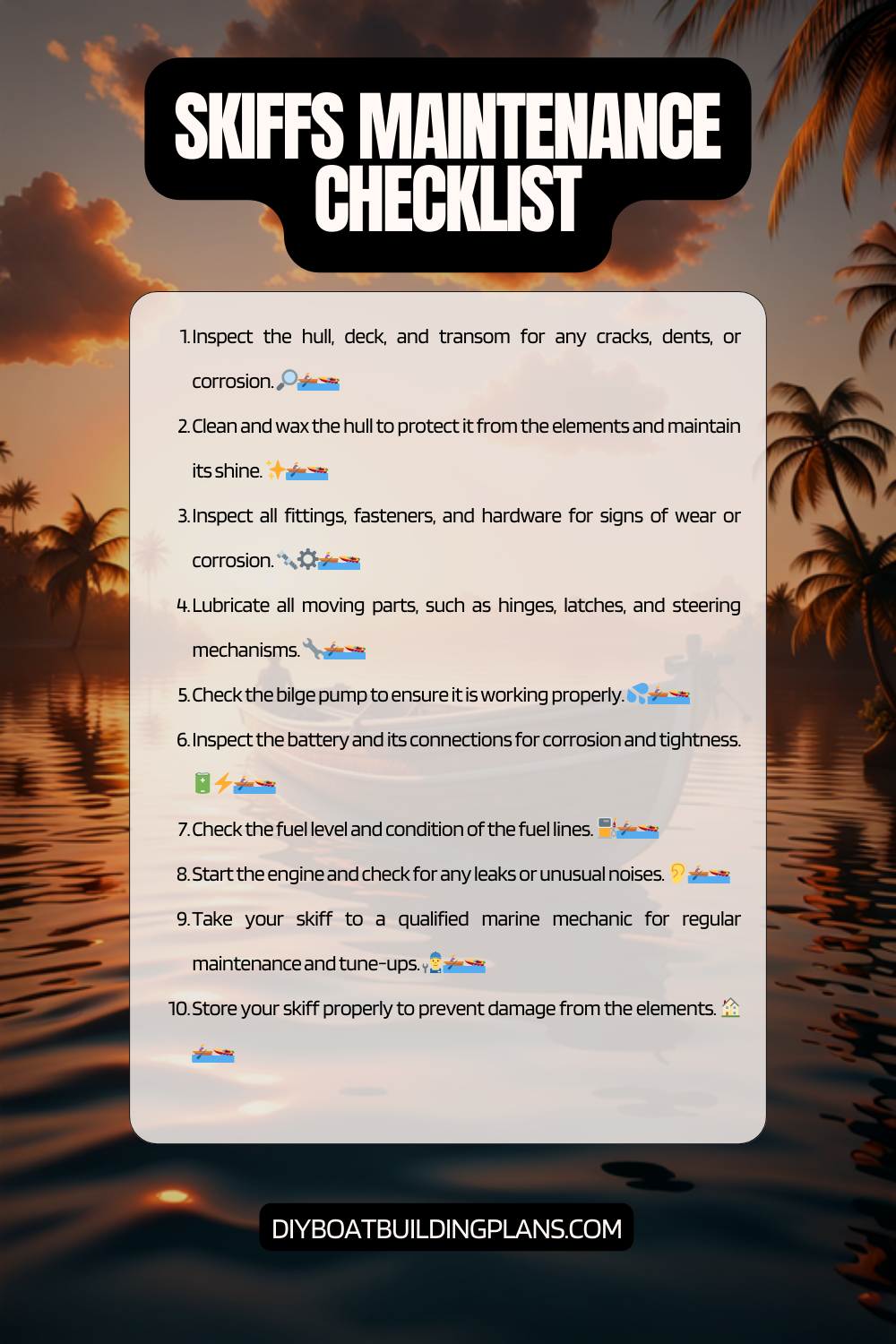Overview of Skiff Maintenance Tips
A skiff is a small, flat-bottomed boat typically used for fishing or recreational purposes. It is important to properly maintain a skiff to ensure its longevity and optimal performance. Skiffs are often exposed to harsh environmental conditions such as saltwater, UV rays, and debris, which can cause wear and tear over time. Regular maintenance is crucial to keep the skiff in good condition and prevent any potential issues that may arise.
Key Takeaways
- Regular skiff maintenance is crucial for ensuring optimal performance and longevity of your vessel.
- Essential tools and equipment for skiff maintenance include a pressure washer, marine-grade cleaning products, and a multimeter.
- Before beginning maintenance, prepare your skiff by removing any debris and securing it in a safe location.
- Regularly checking and replacing skiff fluids, inspecting electrical systems, and maintaining engine and propulsion systems are all important aspects of skiff maintenance.
- Properly storing your skiff, including covering it and removing the battery, can help prevent damage and prolong its lifespan.

Importance of Regular Skiff Maintenance
Regular maintenance of a skiff offers numerous benefits. Firstly, it helps to extend the lifespan of the boat. By addressing any minor issues promptly, you can prevent them from escalating into major problems that could potentially render the skiff unusable. Additionally, regular maintenance ensures that the skiff operates at its peak performance, allowing for a smoother and more enjoyable boating experience.
On the other hand, neglecting skiff maintenance can have serious consequences. Over time, dirt, grime, and saltwater residue can accumulate on the hull, leading to corrosion and deterioration of the boat’s structure. This can weaken the integrity of the skiff and compromise its safety. Furthermore, failing to maintain essential components such as the engine or electrical systems can result in breakdowns or malfunctions while out on the water, putting both you and your passengers at risk.
Essential Tools and Equipment for Skiff Maintenance
To properly maintain a skiff, it is important to have a set of basic tools on hand. These include screwdrivers, wrenches, pliers, and a socket set. These tools will allow you to perform simple tasks such as tightening loose screws or bolts and replacing worn-out parts.
In addition to basic tools, there are several additional equipment options that can aid in more advanced skiff maintenance. A pressure washer can be used to effectively remove stubborn dirt and grime from the hull and deck. A multimeter is essential for testing electrical systems and diagnosing any issues. A marine-grade grease gun is useful for lubricating moving parts, such as the steering system or trailer components. Finally, a boat lift or trailer is necessary for lifting the skiff out of the water for more extensive maintenance tasks.
Preparing Your Skiff for Maintenance
| Task | Frequency | Time Required | Tools Required |
| Inspect hull for damage | Monthly | 30 minutes | Flashlight, scraper, sandpaper |
| Check battery charge | Weekly | 10 minutes | Multi-meter |
| Change engine oil | Every 100 hours of use | 1 hour | Oil filter wrench, oil drain pan, funnel |
| Replace spark plugs | Every 100 hours of use | 30 minutes | Spark plug socket, gap gauge |
| Clean and lubricate trailer | After every use | 1 hour | Pressure washer, grease gun |
Before beginning any maintenance tasks, it is important to take certain safety precautions. Ensure that the skiff is securely moored or on a stable surface to prevent accidents or injuries. If working on the boat in water, wear a life jacket and have a safety line attached to you as an extra precaution. Additionally, make sure to disconnect the battery and turn off all electrical systems to avoid any potential electrical shocks.
To prepare your skiff for maintenance, start by thoroughly cleaning the boat. Remove any debris, dirt, or marine growth from the hull, deck, and other surfaces using a mild detergent and a soft brush or sponge. Rinse the skiff with fresh water to remove any remaining soap residue. This step is crucial as it allows you to inspect the boat more effectively and identify any areas that require attention.
Cleaning and Polishing Your Skiff
Cleaning and polishing your skiff not only enhances its appearance but also protects it from corrosion and damage caused by exposure to saltwater and UV rays. Regular cleaning removes salt deposits and other contaminants that can eat away at the boat’s finish.
To properly clean your skiff, start by applying a marine-grade cleaner to the hull and deck. Use a soft brush or sponge to scrub away dirt and grime, paying special attention to hard-to-reach areas such as corners and crevices. Rinse the boat thoroughly with fresh water to remove all traces of cleaner.
After cleaning, it is important to apply a protective wax or polish to the skiff’s surfaces. This helps to create a barrier against UV rays and saltwater, preventing oxidation and corrosion. Apply the wax or polish using a clean cloth or applicator pad, following the manufacturer’s instructions. Allow the product to dry and then buff it off with a clean, dry cloth to achieve a shiny and protective finish.
Checking and Replacing Skiff Fluids
Regularly checking and replacing fluids in your skiff is essential for maintaining its performance and preventing potential damage. There are several types of fluids that need to be monitored, including engine oil, coolant, hydraulic fluid, and gear oil.
To check the engine oil, start by ensuring that the skiff is on a level surface. Remove the dipstick, wipe it clean, and reinsert it fully. Remove the dipstick again and check the oil level. If it is below the recommended level, add the appropriate type of oil until it reaches the correct level.
Coolant levels should also be checked regularly. Locate the coolant reservoir and ensure that the fluid is between the minimum and maximum marks. If necessary, add a mixture of coolant and water to maintain the proper level.
Hydraulic fluid is crucial for the operation of steering systems, trim tabs, and other hydraulic components. Check the fluid level in the reservoir and top up if necessary using the recommended type of fluid.
Gear oil is used in the lower unit of outboard motors to lubricate gears and bearings. Inspect the gear oil by removing the drain plug or dipstick. The oil should be clear with no signs of water or metal particles. If any abnormalities are detected, it may be necessary to drain and replace the gear oil.
Inspecting and Maintaining Skiff Electrical Systems
Proper maintenance of electrical systems is vital for ensuring safety and reliability while out on the water. Regular inspections can help identify any issues before they become major problems.
Start by visually inspecting all electrical connections for signs of corrosion or loose connections. Clean any corroded terminals using a wire brush or sandpaper and apply a corrosion inhibitor to prevent further corrosion.
Check all electrical components, such as lights, pumps, and gauges, to ensure they are functioning properly. Replace any faulty or burned-out bulbs or fuses.
Inspect the battery for any signs of damage or corrosion. Clean the battery terminals using a mixture of baking soda and water, and ensure that the connections are tight. Test the battery voltage using a multimeter to ensure it is within the recommended range.
Regularly check the wiring harness for any signs of wear or damage. Repair or replace any damaged wires to prevent electrical shorts or malfunctions.
Maintaining Skiff Engine and Propulsion Systems
The engine and propulsion systems are the heart of a skiff, and proper maintenance is crucial for their longevity and performance.
Regularly inspect the engine for any signs of leaks, loose connections, or worn-out parts. Check the fuel lines, hoses, and clamps for any cracks or deterioration. Replace any damaged components immediately.
Change the engine oil and oil filter at regular intervals as recommended by the manufacturer. This helps to remove contaminants and ensure proper lubrication of engine components.
Inspect the propeller for any signs of damage or distortion. Remove any debris or fishing line that may be wrapped around the propeller shaft. Grease the propeller shaft with marine-grade grease to prevent corrosion.
Check the fuel system for any water contamination or debris. Drain any water from the fuel filter and replace it if necessary. Use a fuel stabilizer to prevent fuel degradation during periods of storage.
Repairing and Replacing Skiff Parts
Over time, certain parts of a skiff may require repair or replacement due to wear and tear or damage. Common parts that may need attention include steering systems, pumps, lights, and trailer components.
If you notice any issues with the steering system, such as excessive play or stiffness, it may be necessary to replace worn-out components such as the steering cable or helm. Ensure that all connections are properly tightened and lubricated.
Pumps, such as bilge pumps or livewell pumps, should be inspected regularly for proper operation. Clean any debris or obstructions that may be affecting their performance. Replace any faulty pumps to ensure proper water drainage or circulation.
Lights are essential for safe boating, especially during low-light conditions. Inspect all lights, including navigation lights and interior lights, for any signs of damage or burned-out bulbs. Replace any faulty lights to ensure visibility and compliance with boating regulations.
Trailer components, such as tires, bearings, and lights, should also be regularly inspected and maintained. Ensure that the tires are properly inflated and have sufficient tread depth. Grease the wheel bearings to prevent corrosion and ensure smooth operation. Check all trailer lights for proper functioning and replace any faulty bulbs or wiring.
Storing Your Skiff Properly
Proper storage of a skiff is essential for maintaining its condition during periods of non-use. Improper storage can lead to damage from exposure to the elements or theft.
When storing your skiff, it is important to choose a location that provides protection from the sun, rain, and extreme temperatures. If possible, store the boat in a covered area such as a garage or boat shed. If outdoor storage is the only option, consider using a boat cover to protect the skiff from UV rays and debris.
Before storing the skiff, thoroughly clean and dry all surfaces to prevent mold or mildew growth. Remove any valuables or electronics from the boat to prevent theft.
If storing the skiff on a trailer, ensure that the tires are properly inflated and that the trailer is securely parked on a level surface. Use wheel chocks to prevent any movement while in storage.
Download over 500 Boat Plans. Click on the link below.
-->Click Here<--
Skiff Maintenance Checklist

Conclusion – Skiff Maintenance Tips
In conclusion, regular maintenance is essential for keeping your skiff in optimal condition and ensuring a safe and enjoyable boating experience. By following the tips outlined in this article, you can extend the lifespan of your skiff, prevent major issues, and maintain its performance.
Remember to regularly clean and polish your skiff to protect it from corrosion and damage caused by exposure to saltwater and UV rays. Check and replace fluids such as engine oil, coolant, hydraulic fluid, and gear oil to maintain proper operation. Inspect and maintain electrical systems to ensure safety and reliability. Properly maintain the engine and propulsion systems to prevent breakdowns or malfunctions. Repair or replace any worn-out or damaged parts promptly. Finally, store your skiff properly to protect it from the elements and theft.
By dedicating time and effort to skiff maintenance, you can enjoy many years of trouble-free boating and create lasting memories on the water.
FAQs – Skiff Maintenance Tips
What is a skiff?
A skiff is a small, flat-bottomed boat typically used for fishing or transportation in shallow waters.
Why is skiff maintenance important?
Skiff maintenance is important to ensure the safety of the passengers and to prolong the life of the boat. Regular maintenance can also prevent costly repairs in the future.
What are some basic skiff maintenance tips?
Some basic skiff maintenance tips include washing the boat after each use, checking the oil and fuel levels before each outing, inspecting the hull for damage, and storing the boat properly when not in use.
How often should I wash my skiff?
It is recommended to wash your skiff after each use to remove salt, dirt, and other debris that can damage the boat over time.
What should I use to wash my skiff?
You can use a mild soap and water to wash your skiff. Avoid using harsh chemicals or abrasive materials that can scratch or damage the boat.
How often should I check the oil and fuel levels?
It is recommended to check the oil and fuel levels before each outing to ensure that the boat is running properly and to prevent any potential issues on the water.
What should I do if I notice damage to the hull?
If you notice damage to the hull, it is important to address it as soon as possible to prevent further damage. You can repair minor damage yourself or take the boat to a professional for more extensive repairs.
How should I store my skiff when not in use?
When not in use, it is recommended to store your skiff in a dry, covered area to protect it from the elements. You can also use a boat cover to further protect the boat.



